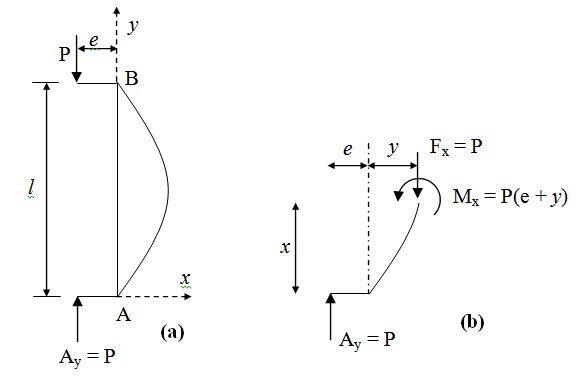Site pages
Current course
Participants
General
MODULE 1. Analysis of Statically Determinate Beams
MODULE 2. Analysis of Statically Indeterminate Beams
MODULE 3. Columns and Struts
MODULE 4. Riveted and Welded Connections
MODULE 5. Stability Analysis of Gravity Dams
Keywords
5 April - 11 April
12 April - 18 April
19 April - 25 April
26 April - 2 May
LESSON 23. Columns and Struts
23.1 Limitation Of Euler’s Theory of Buckling
Euler’s formula for buckling load is,
\[{P_E} = {{{\pi ^2}EI} \over {l_{eff}^2}}\] (23.1)
If the cross-section of the column is such that it has different I with respect to different axis, the buckling load is given by,
\[{P_E} = {{{\pi ^2}E{I_{\min }}} \over {l_{eff}^2}}\] (23.2)
\[\Rightarrow {P_E} = {{{\pi ^2}AE} \over {l_{eff}^2}}{{{I_{\min }}} \over A} = {{{\pi ^2}AE} \over {l_{eff}^2}}k_{\min }^2\] [ \[{k_{\min }} = \sqrt {{{{I_{\min }}} \over A}} \] is minimum the radius of gyration ]
\[\Rightarrow {{{P_E}} \over A} = {\pi ^2}E{\left( {{{{k_{\min }}} \over {{l_{eff}}}}} \right)^2}\] (23.3)
Now \[{{P_E}} /{E \le {\sigma _c}}\] , where, σc is the crushing stress of a short column. Therefore,
\[{\pi ^2}E{\left( {{{{k_{\min }}} \over {{l_{eff}}}}} \right)^2} \le {\sigma _c}\]
\[\Rightarrow {{{l_{eff}}} \over {{k_{\min }}}} \ge \sqrt {{{{\pi ^2}E} \over {{\sigma _c}}}}\]
Therefore the Euler buckling theory is applicable only when the slenderness ratio \[{{{l_{eff}}} /{{k_{\min }}} \] has a minimum value. For instance, mild steel has the following properties,
E = 208GPa
σc = 320MPa
\[{{{l_{eff}}} \over {{k_{\min }}}}=\ge \sqrt {{{{\pi ^2}208 \times {{10}^9}} \over {320 \times {{10}^6}}}}=80\]
Therefore, for mild steel column if the slenderness is greater than 80, then only the Euler theory can be applied in order to predict the buckling load.
Moreover, in Euler’s theory it was assumed that the member is perfectly straight and homogeneous. Moreover the line of action of the applied load is assumed to be coincident with the centroidal axis of the column and therefore does not produce any moment. However in practical situations, column which satisfies all these idealization does not exist. This imposes further limitation on the direct application of Euler model in practical columns. In this lesson we will study the behavior of imperfect column and compare it with the Euler model derived in the last lesson.
23.2 Eccentrically Loaded Columns – Secant Formula
Consider an eccentrically loaded slender column as shown in Figure 23.1a.

Fig. 23.1.
The equation of elastic line becomes,
\[{{{d^2}y} \over {d{x^2}}}=-{{{M_x}} \over {EI}}\] (23.1)
\[\Rightarrow {{{d^2}y} \over {d{x^2}}} + {P \over {EI}}\left( {e + y} \right) = 0\] (23.2)
\[\Rightarrow {{{d^2}y} \over {d{x^2}}} + {k^2}y=-{k^2}e\] (23.3)
where, \[{k^2} = {P / {EI}}\]
The general solution of equation (23.3) is,
\[y=A\cos kx + B\sin kx - e\] (23.4)
Constants A and B are determined from the boundary conditions as follows,
\[y(x = 0)=0 \Rightarrow A=e\]
\[y(x = l)=0 \Rightarrow B={{1 - \cos kl} \over {\sin kl}}e\]
Substituting A and B in equation (23.4) yields,
\[y=\left( {\cos kx + {{1 - \cos kl} \over {\sin kl}}\sin kx - 1} \right)e\] (23.5)
Lateral deflection at mid-height (y = l/2),
\[{\left. y \right|_{x = l/2}}=\left( {\cos {{kl} \over 2} + {{1 - \cos kl} \over {\sin kl}}\sin {{kl} \over 2} - 1} \right)e\] (23.6)
\[\Rightarrow {\left. y \right|_{x = l/2}}=\left( {\sec {{kl} \over 2} - 1} \right)e\] (23.7)
Writing equation (23.7) in terms of Euler load \[{P_E}={\pi ^2}EI/{l^2}\] ,
\[{\left. y \right|_{x = l/2}}=\left[ {\sec \left( {{\pi\over 2}\sqrt {{P \over{{P_E}}}} } \right) - 1} \right]e\] (23.8)
Suggested Readings
Yoo, C.H., Lee, S.C. (2011). Stability of Structures: Principles and Applications. Elsevier.
Gere, J.M, Timoshenko S.P. (2010). Theory of Elastic Stability. Second Edition, Tata McGraw - Hill Education.